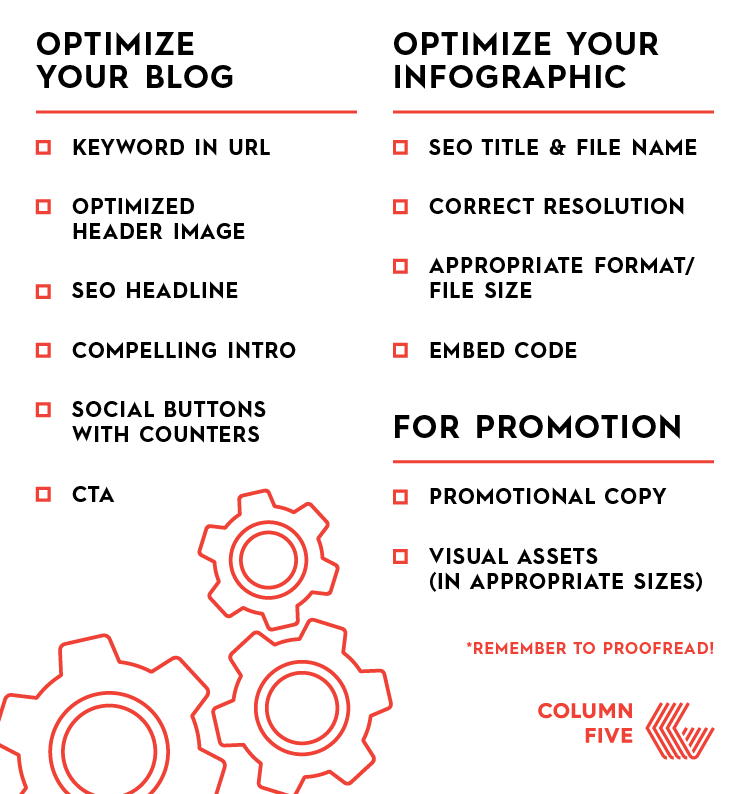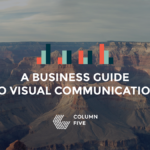A HubSpot study shows that 61% of marketers view increasing organic visibility as their top priority. And infographic marketing is a great way to do that. However, you can’t just publish an infographic and call it a day. You need to optimize that infographic for SEO. But how do you do that? This handy guide outlines everything you need to know about creating SEO-friendly infographics.

Why Infographics Work for SEO Strategy
Infographics provide information in an easy-to-digest format, helping people get valuable information more quickly. This appeals to online users who often scan content rather than read word-for-word.
Infographics Generate Backlinks
One of the significant benefits of an infographic involves generating valuable backlinks. Since infographics are visually appealing and informative, other websites are more likely to link to them as a resource. These “organic backlinks” are gold for SEO, as they tell search engines that the site is an authority on the subject.
Enhancing Engagement with Visuals
Engaging visuals keep people on a website longer. (And dwell time is a notable factor in search rankings.) A well-designed infographic entices searchers to stop scrolling and start reading, which tells search engines that your content is engaging.
Rankings in Google Images
Don’t forget that many people search specifically for images. Optimizing an infographic puts it in the running for Google Images results. This is a separate but powerful stream of organic traffic. (Again, when an image represents a complex topic well, users often click through to the website to read the full context.)
A Simple Guide to Seo Friendly Infographics
Search engines cannot “see” visual elements the way humans do. You must provide the context they need through text and code. Following these steps before hitting publish will help you increase your infographic visibility, reach, and engagement.
Step 1) Design for SEO
Legibility makes or breaks the user experience. You need to stick to distinct fonts and ensure every bit of text is large enough for someone scrolling on a smartphone. If the text is too tiny, people simply leave rather than squinting. This sends the wrong signal to search engines and hurts the page’s performance. Think of it like a highway sign; if drivers cannot read it in a split second, it fails to do its job.
Using Data Visualization Effectively
Infographics transform complex numbers into something people grasp instantly. Pie charts, bar graphs, and maps help statistics stay in memory long after the tab closes. When information is easy to digest, people feel smarter and are much more likely to share it with their network. A spreadsheet puts people to sleep, but a vibrant visualization wakes them up.
Creating Compelling Infographics
To get real results, the work needs to be genuinely interesting. A graphic that offers zero new value or looks like a rush job will not earn mention from other sites. Top-tier design and verified data are the price of admission here. You wouldn’t serve a burnt cake to guests, so don’t serve sloppy graphics to the people you want to reach.
Structuring the Infographic Narrative
Great visuals guide the viewer through a specific story. Establishing a clear beginning, a detailed middle, and a strong conclusion keeps the eye moving down the page. This flow ensures the viewer stays engaged from the headline to the footer. The story inside the graphic must also align with the written content around it so the whole page feels cohesive.
Other Visual Elements
While the main infographic acts as the centerpiece, supporting visuals do a lot of heavy lifting. Small illustrations or custom icons break up walls of text in the actual post. These little visual pauses make the entire page feel lighter and more approachable. It turns a dense article into an experience people actually enjoy scrolling through.
Step 2) Find Your Optimization Keyword
It all starts with finding the right keyword for your topic. Your infographic should be shaped around a clear topic, and your job is to choose the most relevant keyword for that topic. This helps search engines understand exactly what the content or infographic is about. (For example, this very article targets “infographic for SEO.”)
Selecting Relevant Keywords
You want a term you can realistically rank for regarding a specific niche. To discover the best options, see our guide to choosing the right keywords or take a look at HubSpot’s beginner’s guide for doing keyword research serves as a great start.
Identifying Long Tail Keywords
General terms often suffer from too much competition and high search volume. This makes them difficult to conquer. Using long-tail keywords—phrases that are more specific and often longer—can attract a more targeted group. These keywords often indicate a higher search intent for a specific topic.
Planning Before Creating Content
Ideally, you want to identify keywords before creating infographics. This approach ensures infographics are relevant, saving time and increasing your chances of success.
Step 3) Optimize Your Infographic for SEO
Once the keyword is selected, you are ready to optimize the infographic for SEO. While many tasks might look like minor details, completing every step is crucial for maximizing organic traffic.

Where to Add Your Keyword
Strategic placement of a keyword phrase signals to search engines that the content is relevant to the topic at hand, so make sure to optimize:
- URL: Make sure the keyword phrase is clearly placed within the URL, as this is a primary element search engines use to determine the web page topic. (You’ll notice the phrase “infographic for SEO” appears in this post’s URL for that reason.)
- Headline: Write a catchy headline that includes the keyword. This captures attention and assists with ranking.
- Meta Description: A good meta description acts as a pitch to potential readers on the search results page. Add a compelling description and include the keyword there to improve click-through rates.
- H1 Headings: Add the keyword phrase in the H1 heading. This signals the main topic effectively.
- Subheadings: Include relevant keywords in other header tags throughout the text. This organizes the content for both readers and bots.
Optimizing the Infographic File
The file itself requires attention. Make sure the infographic image file saves at the right resolution to avoid losing quality while keeping file size manageable. Also, include the keyword in the filename. For example, “infographic-seo-strategy.jpg” is far better than “IMG_12345.jpg.” This applies to any blog banners or article images accompanying the post, too.
The Importance of Image Alt Text
Search engines can’t crawl the content of images like they read text. They simply acknowledge that an image exists. You must tell the search engines what your images are using image alt text. If you design infographics about the best restaurants in New York, the alt text should read “Best New York Restaurants Infographic.” This provides context. It helps the infographic appear in Google Images.
Accessibility and Screen Readers
Beyond ranking benefits, alt text serves a vital function for accessibility. Screen readers use this text to describe the image to visually impaired users. Writing descriptive, accurate alt text ensures visual content is inclusive and accessible to everyone.
Step 4) Optimize Your Infographic Page
The environment where the infographic lives, whether a blog post or landing page, must also be optimized.
Including Sufficient Word Count
Search engines take various page features into account when crawling a blog post. This includes page length. Generally, search engines favor longer posts as long as they are optimized correctly. Aiming for posts of at least 1,000 words ensures there is enough context for the search engine to index. Make sure to include keywords naturally throughout this text, too.
Balancing Text and Visuals
The infographic is the star, but the text supports it. Creating content that expands on the points made in the infographic adds value and gives you more opportunities to use relevant keywords without stuffing. This combination of text and visual elements creates a robust page that satisfies search intent.
Watching Load Times
Page speed is critical. Make sure the page loads quickly and correctly. If a page takes forever to load, Google will be less likely to offer it as a suggestion. Free tools help audit how Google judges your page load time. Large infographic files often cause slow speeds, so compressing the infographic file is ideal to ensure a smooth experience.
Monitoring Bounce Rate
Watch your bounce rate closely. Similar to page load times, Google’s main priority is serving up content that provides value. If a page has an incredibly high bounce rate, Google assumes people aren’t interested in the content and won’t show it in the results page. An engaging introduction and clear formatting keep people on the page longer.
Social Sharing Integration
Sharing is crucial for traffic, and optimizing social sharing buttons encourages distribution. Ensure share buttons work correctly and remain visible as the user scrolls. (Increased social activity also signals to search engines that the content is popular.)
To facilitate link building, you can also provide an embed code for every infographic. An embed code is a snippet of HTML. It allows other websites to host the image on their page while automatically linking back to your site. This makes it incredibly easy for others to share content, increasing the number of inbound links.
Visible Calls to Action (CTAs)
Don’t let traffic go to waste. Provide a next action to help convert visitors, whether it’s a download, a subscribe button, a contact form, or another CTA. This turns organic traffic into tangible business results.
Simplifying the Process with Plugins
If this list seems overwhelming to remember, various SEO plugins exist to simplify the process. For example, websites run via WordPress often use an SEO plugin called Yoast. The tool ensures pages hit the checklist before hitting publish. It offers reminders to check keyword density, meta description, and alt text.
Step 5) Consider Re-Optimizing Underperforming Content
If you have quality infographics that were never properly optimized, now is the time to revisit them. Refreshing old posts with optimized headers, titles, and keywords is a great strategy to capture extra traffic in general, but it’s especially helpful to give infographics that extra boost.
Analyzing Historical Performance
Look at analytics to identify pages with high potential but low traffic. These are prime candidates for re-optimization, and updating the meta description or improving the introduction can sometimes spark new life.
Updating the Infographic Content
Sometimes the data visualization itself needs a refresh. If the data in the infographic is outdated, updating the numbers and re-publishing the infographic signals freshness to search engines and helps maintain valuable backlinks while providing current information.
Results from Re-optimization
This strategy works wonders for older posts, often yielding an average 20% increase in organic traffic after updating. (If you are unsure if infographics are hitting the mark, learning how to fix the most common infographic mistakes helps improve results.)
Learn How to Get More Traffic with Better Distribution
These tips for improving SEO are helpful. However, strictly relying on organic search isn’t the only way to get eyes on content. You need a smart plan to deliver your content through the right channels.
Developing a Distribution Plan
Media Outreach: Earned media is especially valuable to increase visibility. Reaching out to publications and influencers amplifies your content’s reach. Plus, publishers love visual content like infographics, so producing them regularly can increase your chances of placement. Learn how to get featured in major media by using a publication-tailored strategy. (You can also use this guide to determine the best distribution channels for specific content and goals.)
Leveraging Social Media Platforms
Social media platforms are ideal for sharing visual content. An infographic can be sliced into smaller “micro-content” pieces for Instagram, LinkedIn, or Twitter. Each piece should link back to the main infographic page on the website to drive referral traffic.
Email Marketing Integration
Include compelling infographics in email newsletters. This puts the content directly in front of subscribers, prompting clicks and shares.
Paid Promotion Options
If organic reach is slow, consider paid promotion. Boosting a post containing an infographic can jumpstart visibility and attract the initial round of shares needed to gain momentum.
Monitoring SEO Results
Tracking progress is essential. Review search rankings for the target keyword regularly, and check analytics to see which infographics drive the most traffic and conversions.
Iterating Your SEO Strategy
SEO is not a one-and-done task. Search engines change algorithms. Competitors adjust tactics. The strategy must evolve. Regularly reviewing infographic performance ensures you stay ahead.
Recap of Key Steps
To summarize the path to SEO success:
- Conduct thorough keyword research to find a target keyword.
- Create compelling infographics that address search intent.
- Name the infographic file with the keyword.
- Write descriptive image alt text.
- Craft a good meta description.
- Publish on a page with substantial text and header tags.
- Include an embed code to encourage link building.
- Promote across digital marketing channels.
Final Thoughts on Infographic SEO
Optimizing infographics for SEO does not have to be a headache. By systematically applying these best practices, you ensure your visual content works as hard as you do. You’ve spent the time to design infographics that are beautiful and informative, so take the extra steps to ensure search engines understand them.
That said, if getting more eyes on content seems daunting or you could use a little help with strategy, let’s talk about how we can help scale your content strategy.






